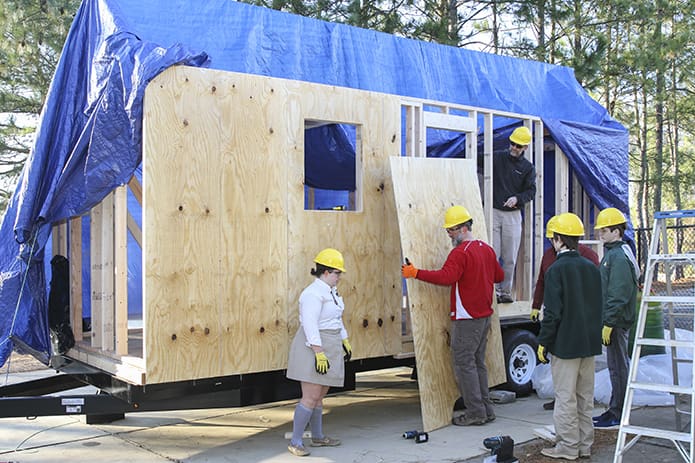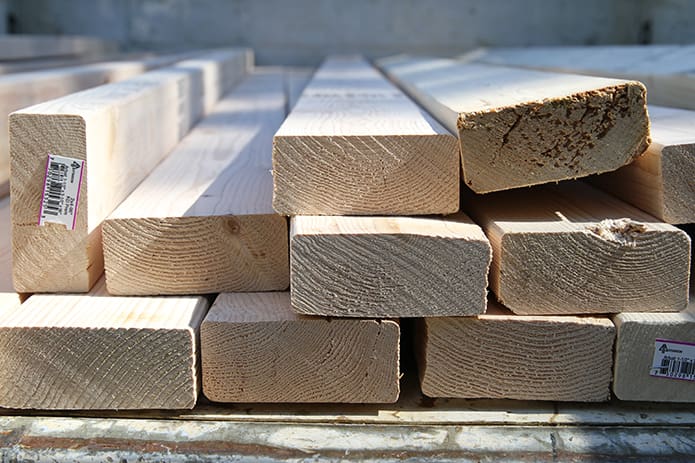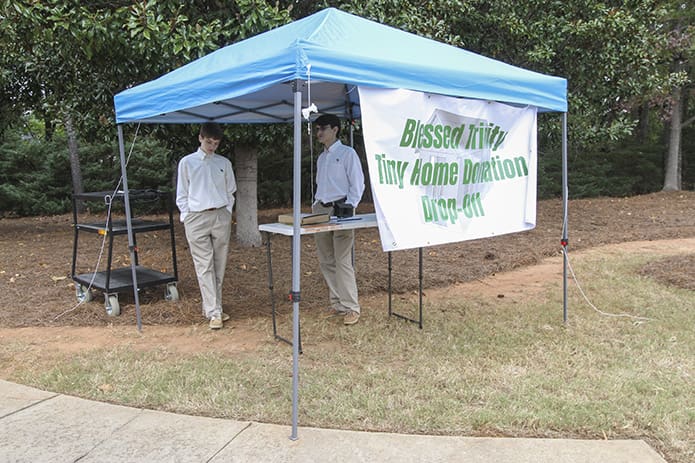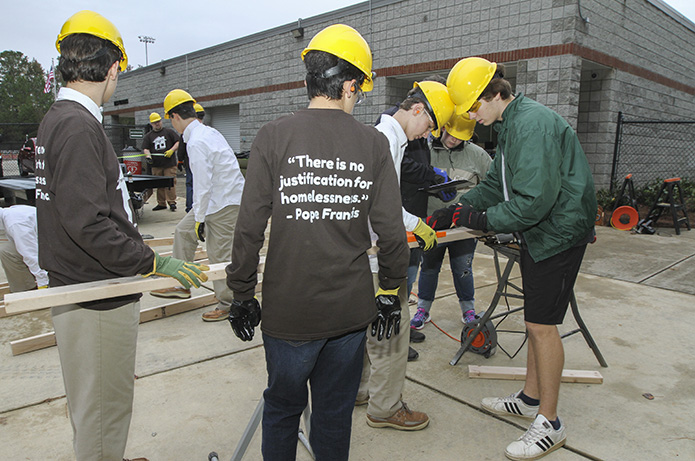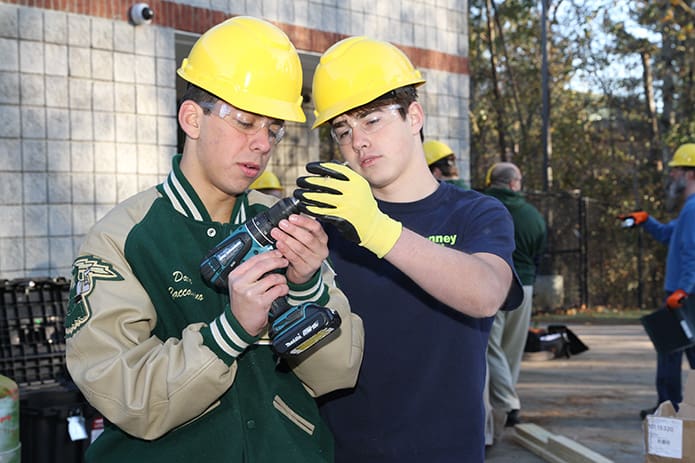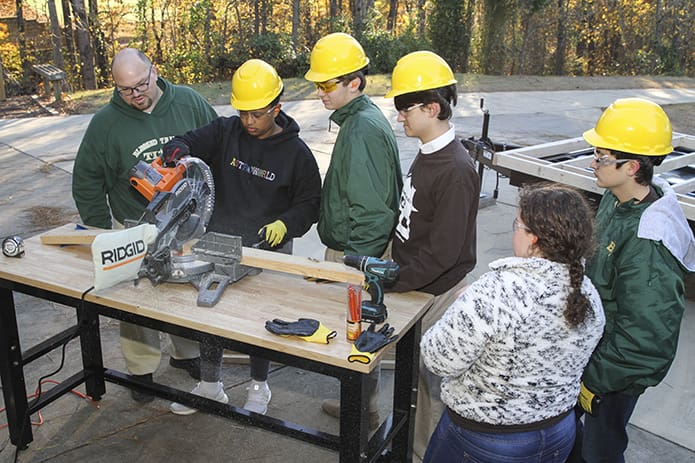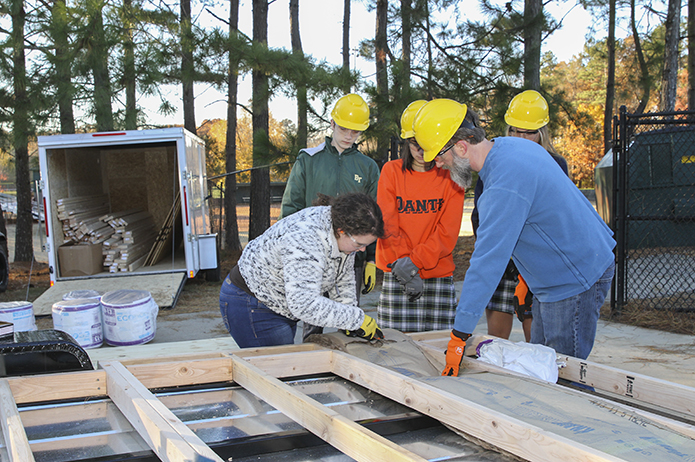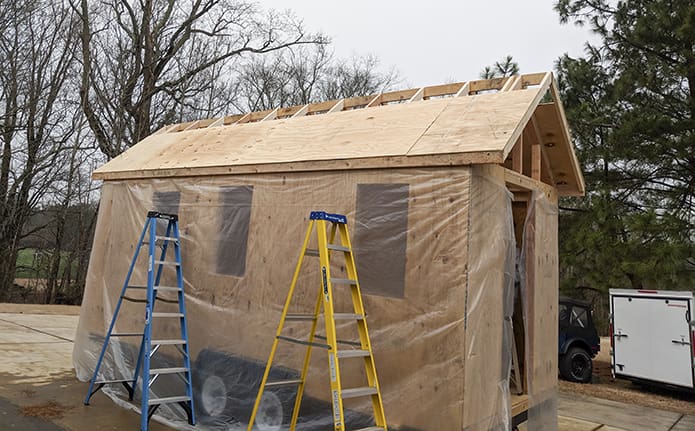(Clockwise, from top right) Scott Findlay, business education teacher; Dr. Brent Hollers, project manager and business and technology education teacher; freshmen Matthew Stevens and C.J. Van Zant, and senior Rosie Nemec watch as Jason Podhorez, project manager and the school’s computer systems administrator, moves one of the exterior wall panels in place on the east side of the tiny home. Photo By Michael Alexander
Roswell
Blessed Trinity students build tiny home to share
By ANDREW NELSON, Staff Writer | Published February 21, 2019
ROSWELL—Rosie Nemec wasn’t going to let the lack of experience with circular saws, nail guns, impact drills and other construction tools stop her.
A graduating senior, Nemec hopes to be a nurse. However, the chance to work with her hands to build a home—and not just any home, but a popular tiny house for a person in need—intrigued her.
“It was a new experience for me,” said Nemec. “I wanted to help the school and the homeless vet we’re giving the house to.”
Behind Blessed Trinity High School’s engineering lab, students like Nemec have put up this micro house together.
Students at the Roswell high school are constructing a tiny house on wheels. It measures just under 200 square feet. On a custom-built wheeled trailer, this home will include a sleeping loft for a king bed and a twin, a kitchen and a bathroom with a standup shower, along with a sitting area.
Nemec was not intimidated by the work. The instructors welcomed all students, whether they had done home renovation before or not. Nemec has been cutting the wood as students built the frame of the house and its roof.
It’s part of an effort by the school to knit varied subjects into school projects, linking religion and the arts to engineering and technology. It is the first tiny house built on campus.
Building from the bottom up
Students started from the bottom as they installed the floor on the trailer, nailed the upright studs then attached the plywood sheathing. They installed the roof rafters. They learn safety techniques for handling new tools.
There’s lots of basic instructions including how to read a tape measure or measuring to cut wood.

Juniors David James, left, and Marcus Solomon prepare to install another roll of insulation to the tiny home’s sub-floor. Photo By Michael Alexander
“We always ask the question, ‘who has not done this before?’ They know what they are getting into before they go out with a bunch of lumber,” said Jason Podhorez, one of the school staff members leading the effort. “Students gain comfort with the tools over time and take on more responsibility. It’s a great thing to see.”
Podhorez handles the school’s computer systems.
Freshman Christopher “C.J.” Van Zant is one of the novices. He found a connection between his robotics club activities and the tiny house build; both require precision.
“What surprised me is just how similar it is to the build portion of robotics. Tiny home requires precise measurements and careful installations, similar to building a robot.”
Dylan Uhrik brought experience to the project. The senior, who hopes to study engineering in college, has helped at his family’s rental homes, painting, landscaping and installing a kitchen. Uhrik’s goal is to broaden his skills, as he served as a mentor.
“One thing I didn’t know was plumbing and home electrical. This would be a way to improve upon those skills while helping someone,” he said.
Acting as a mentor helps his fellow students, newcomers to construction.
“I think back to when my father taught me how to use a drill,” Uhrik said. “I try to teach them.”
The tiny home trend
This project—a first for the school—grew of an idea of the students in the fall of 2017 learning about electrical circuits. The project was to wire a micro house on a computer. Students asked about moving from a virtual house to a real one.
The tiny home is part of a minimalist living trend. For comparison, the average house in America is about 2,400 square feet, according to the Census Bureau.
A recommendation during a recent accreditation of Atlanta Archdiocese school system was to develop school projects, tying a school’s science, technology, religion, engineering, arts, and mathematics curriculum together. It is known at STREAM.
School Superintendent Diane Starkovich, Ph.D., said the promotion of school-wide STREAM projects is a local initiative. As a Catholic school system, educators want to expand beyond the hard sciences with science, technology, engineering and math, to include the humanities.
“Since we believe in developing the whole child, art integration throughout our curriculums is also important to us. Thus, we have included religion and art to the traditional STEM concept to achieve STREAM,” she said in an email.
Blessed Trinity High School included this STREAM initiative into campus programs, and added a little bit extra with the Tiny House effort, she said. Other examples are at Holy Redeemer School, where there is a designated STREAM room to work on projects, and the Hyland Center under construction at the Cathedral of Christ the King School will also reflect this priority, she said.
The home-building exercise checks the boxes. There’s an overlap with all the areas to foster a culture of service on campus. Beyond engineering, this project incorporates faith and the arts. The project—built with about $15,000 in donations—draws students with diverse interests, from the robotics club to the fine arts students who will add flair to the interior. The brawn of the football team came in handy to lift the shell of the house up on top of the trailer. Members of the St. Vincent de Paul campus chapter handled marketing the project to parents waiting in the car line.
For the faith component, the goal is to give the finished house to a person in need, a veteran, if possible.
A new skill set for students
Designs and videos from Tiny House Builder, a clearinghouse for the DIY (do it yourself) crowd with visions of downsizing, guides the students’ work.
As a high school focused on preparing students for college, there are few classes with a vocational focus, like drafting or plumbing. This project offers young women and men a taste of the construction trade.
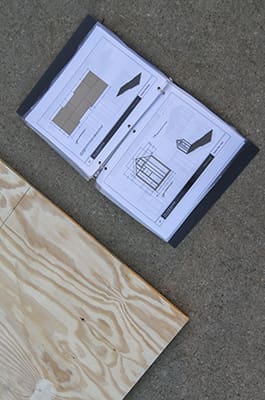
The build plans from Tiny Home Builders serve as a guide and reference during Blessed Trinity’s tiny home project. Photo By Michael Alexander
“It’s a valuable skill to have. All these kids will know how to do a little dry wall. If nothing else, they know how their house was built,” said Brent Hollers, Ph.D., who teaches business and technology education. He is also the mentor of the robotics club, which is contributing many of the builders.
All the leaders have DIY ingenuity. Business education teacher Scott Findlay is a licensed plumber. Last year, Podhorez gutted his bathroom.
Hollers, described as a “jack of all trades,” has a doctorate degree in workforce education, a specialty to help students with vocational instruction. He leads engineering and computer science courses. Hollers also remodeled his bathroom, landscaped his home’s yard and rebuilt an elevated deck. Some students helped refurbish his 1981 Jeep.
Hollers believes the project can go beyond this year. He hopes the campus involvement, the seamless way supporters contribute to the project, and leaning on the ability of the school staff can serve as a model for others.
Students experience working with their hands and living their faith. Other schools may use technology to build a robot as part of a capstone project. Hollers is proud his students created something with an impact, shaping a family’s future.
“Our goal is every year we build one of these things and give it away,” he added.
For this first year, students are drawn to putting in the work to see the project take off. Nemec is one of scores of students who have helped.
“I’ve definitely learned a lot,” she said. “It’s about tools, it’s about the people working on the house.”


